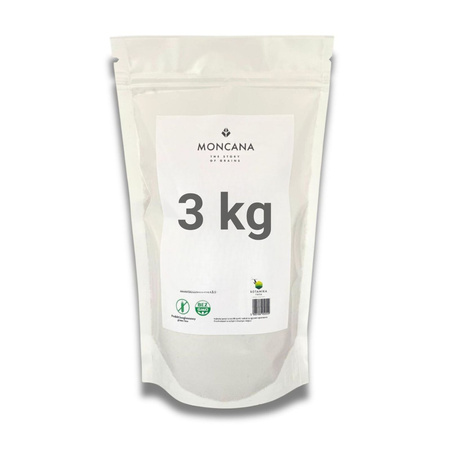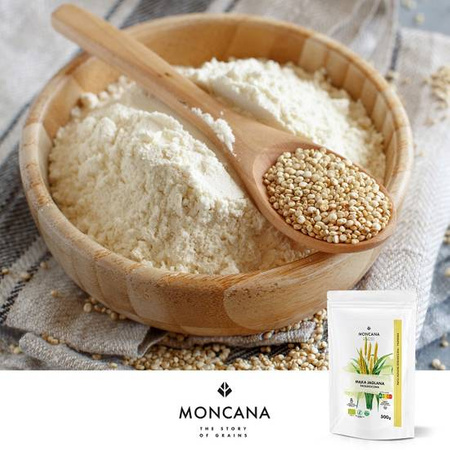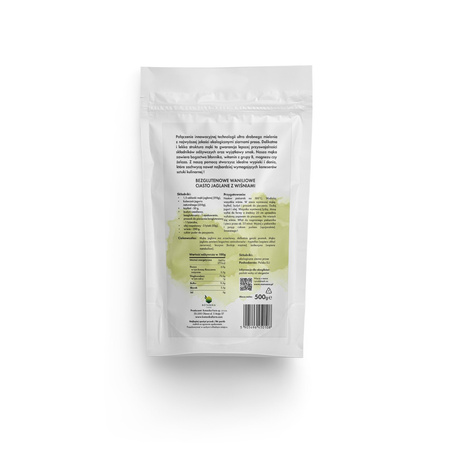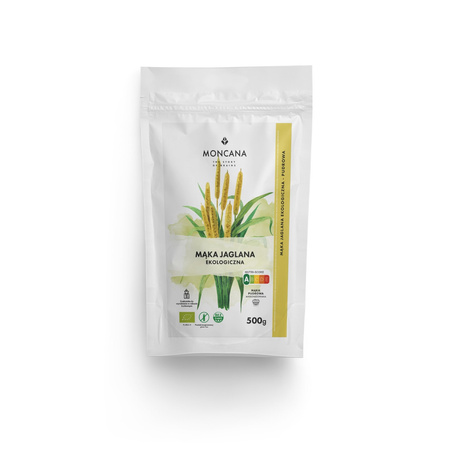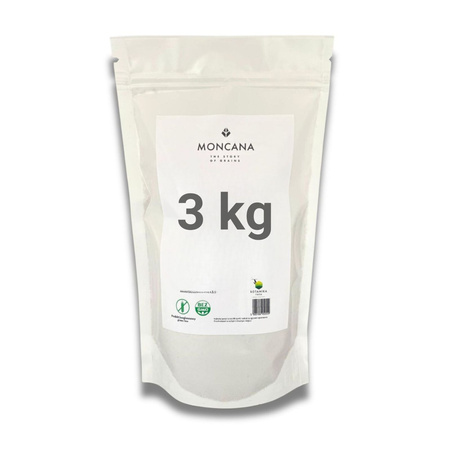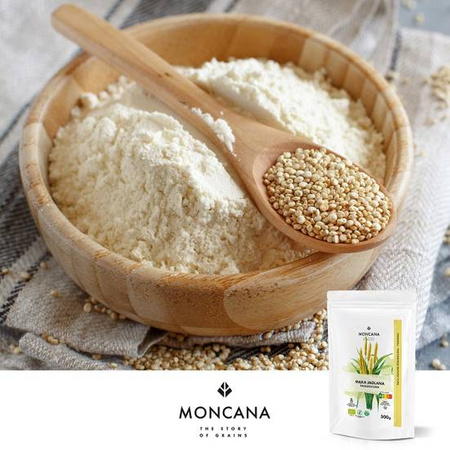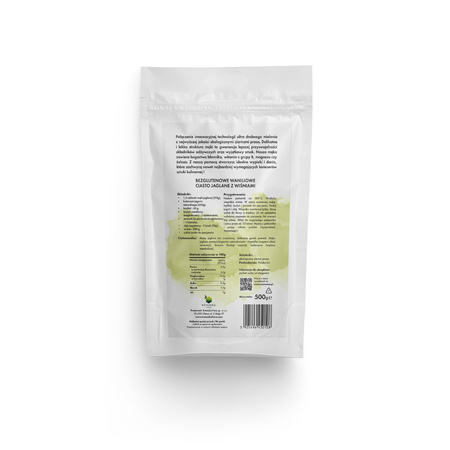
Gluten-free millet flour, powdered flour EKOlogical 3kg
- Gluten-free millet flour contains a lot of fiber, B vitamins, magnesium or iron. It has alkaline-forming properties thanks to which it helps to maintain the acid-base balance of the body.
Now you can buy our flours in larger 3kg packages. Take care of your health by taking care of the environment!
Gluten-free, organic millet flour
Sourced from the finest, organically grown millet grains powdered gluten-free millet flour will enrich your baked goods with a unique, delicate taste. Thanks to the micronization process (i.e. ultra-fine grinding), the bioavailability of valuable nutrients is increased. Barley flour is ideal for those seeking gluten-free alternatives and looking to enrich their diet. Also try our other powdery flours.
Gluten-free millet flour - health properties
Gluten-free millet flour is a very valuable product. High content of dietary fiber improves intestinal function and speeds up metabolism. It is rich in antioxidants, which exhibit anti-inflammatory effects and prevent oxidative stress, which contributes to many diseases of civilization.
Barley flour contains significant amounts of vitamins, including B vitamins, which have a positive effect on the nervous and circulatory systems. People with anemia should include millet in their menu, because millet flour contains elements such as iron, zinc and silicon.
Organic millet flour also has alkaline-forming properties. Why it's so important? Since our diet is rich in acid-forming products (meat, sweets, coffee), so it is advisable to introduce more alkaline-forming products into the menu to maintain acid-base balance and body health.
The millet flour contains the aforementioned silicon, which is involved in bone mineralization and improves overall metabolism. Silicon is also responsible for the beautiful appearance of skin and nails and maintains the elasticity of blood vessels and has a positive effect on the lipid profile (cholesterol and TG).
Millet also contains ideal distribution of essential amino acids - Among other things, tryptophan, which is very often supplied to the body in insufficient amounts.
Gluten-free millet flour is quite caloric, so it will provide a large dose of energy - ideal for athletes, people working physically or mentally.
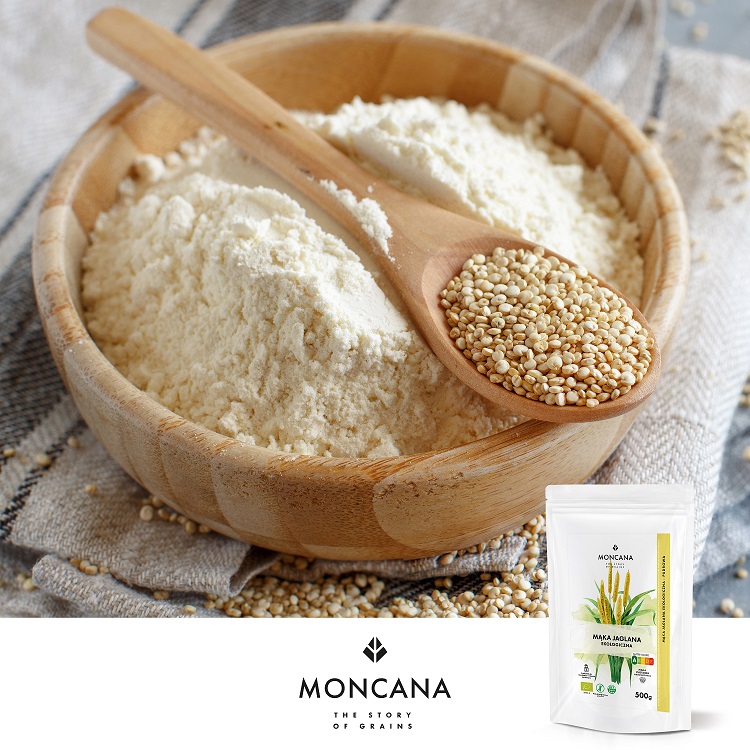
Buckwheat flour - what to use it for?
Lamb gluten-free flour will be a great and versatile substitute for other flours. Since this flour is naturally gluten-free, it will "behave" differently when baking. Gluten is responsible for elasticity and stickiness. That's why baked goods made with millet flour will be more crumbly and softer.
A great many people combine millet flour with other gluten flours like wheat or rye flour. It is not advisable for people with gluten intolerance!
Use of millet flour in the kitchen:
- baking bread and rolls,
- cakes and cookies,
- macarons,
- pancakes, omelets,
- puddings, gruels,
- thickener for sauces and soups.
Dishes made from millet flour are tasty and filling. The millet flour is mildly sweet and nutty in taste, therefore, it is easily suitable for the preparation of various sweet baked goods. Also worth noting is gluten-free millet groats MONCANA.
Interesting facts about millet flour
Barley flour has a high glycemic index (71 GI), therefore, it should not be used in large quantities by people with diabetes.
In China, Africa, and Nepal, common millet is used for brewing beer and for brewing spirits.
Bio millet flour is made from the grains of common millet (Panicum miliaceum), which is an annual plant that grows wild in areas of Asia. Currently, the largest producers of common millet are: China, Nepal, India, Russia, Ukraine, Turkey or Belarus. Common millet is very resistant to prolonged droughts, its roots go deep into the soil to take up enough water.
It is a plant considered to be one of the oldest cultivated by man. The oldest remains of this plant have been discovered in sediments in China and date back some 8,500 years p.n.e.! Millet is gaining popularity in Europe.
Jagella flour in a gluten-free diet
Barley flour is a valued ingredient in a gluten-free diet, especially recommended for people with celiac disease and gluten intolerance. It is made from hulled millet and is distinguished by its easy digestibility and delicate taste. Jagella flour owes its nutritional value to its high content of B vitamins, iron, magnesium and silicon, which supports the condition of skin, hair and nails. It contains no gluten or unnecessary additives, and its natural composition makes it ideal for use in baked goods, pancakes and as a thickener.
By choosing MONCANA products, you can be sure that you are you are reaching for food that is natural, gluten-free and free of unnecessary additives. Check out millet flour and other products in our range - we focus on quality, simple composition and safety in elimination diets.
Hanna Kunachowicz; Beata Przygoda; Irena Nadolna; Krystyna Iwanow: Tables of composition and nutritional value of food. Wyd. II amended. Warsaw: Wydawnictwo Lekarskie PZWL, 2017, p. 331.
Travis L. Goron, Manish Raizada, University of Guelph, 2015 ; "Genetic diversity and genomic resources available for the small millet crops to accelerate a New Green Revolution"
https://www.ecology.en/styl-zycia/zdrowa-zynosc/maka-jaglana-wlasciwosci-sklad-i-zaposowanie-maki-jaglanej,25143.html
Guide


Dairy- and gluten-free tiramisu - nut and chocolate debauchery in a no-compromise version

How to make your own gluten-free flour mix - step by step


